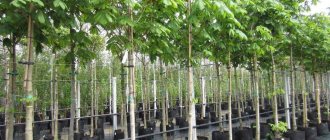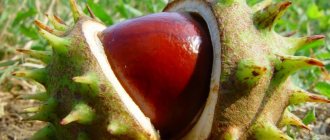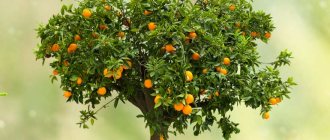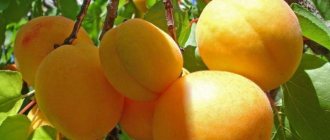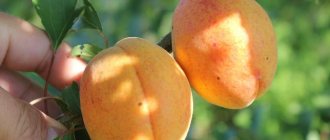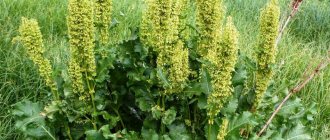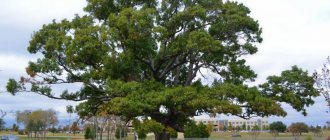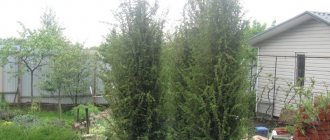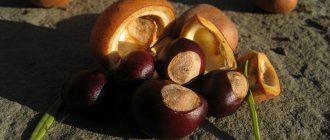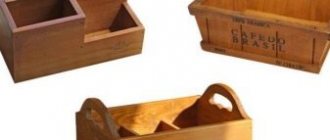Tree pruning goals
Do you know how to prune an apple tree correctly , and what time of year is best to do it? Are you sure that you are forming the crown correctly? If not, our article contains basic recommendations on this topic, and the attached video clearly shows how to prune apple trees in the fall.
Depending on the age of the tree, pruning serves different purposes:
- formation of a beautiful crown of the correct shape;
- strengthening young branches;
- increasing the number of fruiting branches;
- ensuring good access to sunlight for apples;
- removing old branches to replace them with new ones;
- preparing the tree for winter.
In most cases, pruning an old apple tree allows you to save it, and young trees grow and bear fruit better thanks to this procedure.
Chestnut: description, planting and tree care
Chestnut is a beautiful ornamental tree that has become a real decoration of household plots and streets of many cities. A wide crown of unusually beautiful leaves gives shade and coolness, and delicate flowers provide a pleasant light aroma. Some varieties of chestnut have tasty fruits.
Related article: Babako description and features
Thanks to its ability to grow in almost any climatic conditions, chestnut has become a decoration of parks. This tree is most often found in the southern regions of Russia, the Caucasus, and Central Asia. It is used as a crop to decorate city streets, park alleys, and garden plots.
A mature horse chestnut tree reaches a height of 30 meters. The crown of a tree can be shaped like a ball, a pyramid, a column, or have a weeping shape like a willow.
The leaves are large, palmate with a dense surface and green, golden or variegated in color.
Chestnut inflorescences have the shape of a brush. The flowers, depending on the variety, are simple or double, colored white, yellow, pink or red.
The flowering period begins in May , but if there is an increase in temperature in winter, chestnut flowers may bloom.
Fruit ripening occurs at the end of August - beginning of September. Chestnut fruits are edible and taste similar to sweet potatoes. They are also used in folk medicine to prepare tinctures.
When to prune apple trees - in spring, summer or autumn?
Young trees are pruned every year in autumn and spring. Pruning apple trees in the spring is necessary to remove branches frozen in winter, to form the crown and to increase productivity. Spring pruning begins before the sap flows, until the buds appear. In late autumn, when the leaves have fallen, old, damaged, broken, rotten branches are pruned to prepare the tree for winter. In rare cases, apple trees are also pruned in the summer to ensure the best access of light to the fruits. Winter pruning of apple trees is easier to tolerate, since they are in a dormant state, but it can only be carried out in warm southern regions, otherwise the tree bark, which is fragile from frost, will be damaged.
Is it possible to prune an apple tree in the fall, after frosts? It’s better not to do this, otherwise the bark around the place where the branches were cut will freeze, and the wound will take a long time to heal. Try to complete all work on the apple tree before the first frost.
Young trees are pruned every year in autumn and spring
Autumn pruning is carried out as follows:
- First, large broken and dry branches are removed;
- the weakest branches are cut out from those that are located too close to each other;
- branches growing at an acute angle are cut off;
- all damage caused to apple trees during pruning is carefully covered with garden varnish or oil-based paint;
- cut branches are collected and burned.
Methods for pruning branches
There are three types of pruning of apple trees in the fall: weak, medium and strong. Light pruning is done on young apple trees - new branches that have grown during the year are shortened by one quarter of the length. In the spring, fresh shoots will come from the pruned branches and a beautiful crown will form. Medium pruning is used on 5-7 year old apple trees and on old trees also in order to increase the number of productive branches and crown formation. Stronger branches are cut to a third of their length. Strong pruning is necessary to thin out the branches so that the apples ripen better under the sun; for this, the branches are shortened by half.
There are three types of pruning of apple trees in autumn: weak, medium and strong.
A separate type of pruning of apple trees is removing dried branches . It is important here not to make the mistake of cutting a branch right at the trunk of the apple tree, otherwise the dried twig will soon fall out of the tree and a hollow will form, which can ultimately lead to the death of the apple tree. Cut the branch down to the point where the first bud appears. Then use a thin saw with fine teeth to file the stump so that the undercut from the trunk goes towards the branch you are sawing. In this case, it is recommended to treat the cut area not with paint, but with garden varnish. If it rains after this treatment, do it again.
A separate type of pruning of apple trees is the removal of dried branches.
Young apple trees with thin branches are pruned with pruning shears, and stronger branches are cut down with a saw. The tool must be clean and very sharp, sharpened like a razor. Dull garden shears or a hacksaw will greatly “fray” the bark, and the wound will take longer to heal. Only oil paint based on drying oil is suitable for processing; other types of paint will burn the bark like acid. Some gardeners use a disinfectant solution of lime and copper sulfate in a ratio of 10:1 to treat wounds after pruning branches. Please note that immediate treatment is only necessary for old dry branches, and when pruning young branches you need to wait at least a day, and only then cover the cut with paint or varnish.
Pruning of apple trees begins after planting in the first year in order to restore balance between the reduced root system and the spreading above-ground part of the tree, which will require more water and nutrients than the roots can provide. In the next 3-5 years, it is better not to prune young apple trees - only remove broken and dried branches. The shoots should be shortened if the tree grows upward too quickly.
Landing
Selecting a location
Chestnut has a wide crown. It prefers to grow in sunny places, tolerates shade well, but does not bloom well without exposure to direct sunlight.
For normal development, there should be no buildings or plants within a radius of 5 m from the chestnut tree.
Timing
Seedlings are planted in early spring or November, and sprouted nuts are planted in early May or left in the ground in the fall.
Soil preparation
Chestnut has a superficial root system.
To prevent the roots from rotting and the water from stagnating, the tree is planted in moderately moist neutral or slightly acidic loose soil with good drainage. Suitable chernozem or loamy substrate with an admixture of lime and sand. You can add a little clay to sandy soil.
Features of planting seedlings
When growing chestnuts, there should be no plants within a radius of 5 meters from the seedling.
Dig a cubic hole, 50-60 cm deep and wide.
At the bottom, lay a 30 cm thick layer of sand mixed with crushed stone. This will ensure drainage.
If necessary, add humus to the soil mixture; if there is high acidity, add dolomite flour.
When installing a seedling in a hole, make sure that the root collar is at soil level.
To avoid exposing the trunk, make the planting hole 10 cm higher. Upon completion of planting, water the tree with plenty of water (3-4 buckets).
Install supports around the seedling on four sides - this will protect the fragile tree from gusty winds.
Planting process
Chestnuts 2-3 years old are suitable for rooting; sometimes “older” specimens take root. In general, a seedling up to 10 years old may well take root, but only in the spring.
- A cubic-shaped landing hole is dug with parameters of half a meter by half a meter and the same depth.
- A layer of drainage or crushed stone and sand is laid at the bottom. The thickness of this protective layer should be 30 cm.
- A nutritious soil mixture consisting of soil, humus, dolomite flour or lime is placed on the drainage.
- The seedling is buried in the ground, without deepening the measles neck.
- After planting, the tree is watered using 3-4 buckets of water.
- To prevent the plant from falling from the wind, it is tied to strong supports.
When the chestnut roots are strong enough, you can get rid of the supports.
Let's get acquainted with the main points of caring for a chestnut tree.
Weeding
A procedure very important for young plants. Weeding should be combined with not too deep loosening of the top layer of soil. This ensures the permeability of the soil, the roots will “breathe”.
Top dressing
When growing chestnuts, fertilizers should be applied once a year. Fertilize every spring, at the very beginning of the season.
The following components are taken:
- ammonium nitrate - 20 g;
- manure - 1 kg;
- urea - 15-20 g;
- superphosphate - 15 g;
- potassium salt - 10 gr.
All ingredients should be mixed and diluted with water. Fertilizer is applied in liquid form.
In addition to minerals, you can feed chestnuts with organic matter:
- rotted manure;
- green herbal infusions;
- compost;
- humus.
Mulching
In order to supply the chestnut roots with moisture and nutrients longer, it is recommended to mulch the soil under the tree. It is best to use the following organic components as mulch:
The mulch layer should be 10 cm: it will protect both from moisture evaporation and from weeds.
Watering
At a young age, chestnut especially needs watering. Its roots are not yet developed enough to independently obtain moisture. And in principle, the chestnut is a moisture-loving plant: water an adult tree during periods of drought.
Trimming
The chestnut crown should be lush, spreading and powerful. To help the plant form such a crown, the tree needs to be pruned in the spring.
- the upper branches are shortened by a quarter of the length;
- Last year's side shoots are not pruned.
The formative pruning procedure is repeated annually until the chestnut reaches the desired height and its crown becomes as desired.
In the future, formative pruning is not performed, but in case of thickening, branches growing deeper into the crown are removed. Also, no one has canceled sanitary pruning: this procedure is designed to rid the plant of old, dried out, diseased branches.
Important: after pruning, be sure to cover the cuts with garden varnish to avoid infection of the tree.
Wintering
In principle, chestnut in adulthood is quite resistant to frost. And, of course, they don’t hide him. But in the first 2-3 years after planting, the young plant should be protected: cover it with cardboard boxes for the winter.
Protecting the roots won't hurt either. For this purpose, the tree trunk circle is mulched with compost, forming a layer 20 cm thick. It is recommended to wrap the lower part of the trunk with burlap, which will protect it from rodents.
Reproduction
Chestnut is propagated by cuttings, layering, root suckers and seeds. The latter method is used more often; growing a tree from a walnut is not difficult.
Features of seed propagation
Fully ripe fruits are suitable for germination. Use whole and undamaged nuts that have fallen to the ground.
Seeds germinate only after stratification, which can be done under natural conditions - at the end of autumn, plant the collected fruits in open ground and insulate them with dry leaves on top. Many seeds will germinate in the spring.
With this method of propagation, there is a risk of damage to the nut by rodents.
For artificial stratification, the fruit is placed in a tightly closed container filled with wet sand in a cold place for a period of two to five months.
Five days before planting, the fruits are soaked in warm water, which is changed from time to time. This allows the hard nut shell to soften and promotes further germination. Treated chestnuts are planted in the ground to a depth of 8-10 cm.
Growing chestnuts from walnuts in late autumn
At the end of winter, chestnut nuts can be planted in pots, and in May they can be planted in open ground, pinching off the tap root, which will allow the plant to develop a strong root system.
In the first 3 years, and in colder regions - 5 years, the tree is grown in greenhouses, exposed outside for the summer.
You can learn about fast-growing tree species here.
Care in the summer consists of weeding, shallow loosening of the soil, and fertilizing.
Young individuals need regular watering, adults - only in the hot, dry season. Water in the evening.
Top dressing
The tree is fertilized in early spring with the following solution: per 10 liters of water - 1 kg of mullein and 15 g of urea.
In autumn , 15 g of nitroammophoska is mixed into the same volume of water. For fertilizer, the tree trunk circle is also mulched with a 10 cm layer of wood chips, peat or peat compost.
Trimming
Chestnut is formed in the form of a standard tree with a main trunk. To make drooping branches look better, the trunk should be at least 2-3 meters in height.
A central trunk with evenly spaced branches is formed from the main shoot, which is maintained as long as possible.
When the crown is formed, the tree practically does not need pruning. At the beginning of spring, cut off damaged and dry branches.
In summer, if the crown has grown excessively, young shoots are removed. All summer cuts are covered with garden varnish.
Winter care, preparation for winter
The tree is frost resistant.
Only young trees need additional protection in the first 2-3 years after planting. Their trunk circles are mulched with a 20 cm thick layer of fallen leaves, and the trunks are insulated with burlap. If cracks appear on the bark due to severe frosts, an antiseptic is applied to the damaged area and covered with garden varnish.
As the tree matures, its winter hardiness increases.
How to plant a chestnut from a seedling
It is best to plant chestnuts together, when one holds it over the hole, and the other prepares it and adds soil. But, if this is not possible, then the hole is filled to the brim a few days before planting so that the soil settles. Optimally - in two days.
Then a small hole is dug in the center with a depth equal to the length of the root system. The hole is thoroughly watered and the seedling is placed with one hand, and the earth is raked with the other and compacted well. Then the soil around the seedling is properly spilled again.
Caring for planted chestnuts
Care comes down to regular watering, fertilizing, and loosening. If there is a danger that the seedling will break, then it needs to be tied up. The stake is placed so as not to damage the root system. Tie carefully, without pinching or rubbing the bark. Use soft rope or special twine.
When growing any seedling, including horse chestnut, while it is still small, you can mulch the soil with any organic material. It could be:
- fallen leaves;
- sawdust;
- mown grass;
- needles;
- tree bark.
Mulch retains moisture at the soil surface. As it decomposes, it acts as a slow-acting organic fertilizer. Mainly as a source of nitrogen. A soil crust does not form under the mulch and remains loose for a long time. It quickly grows with earthworms, which help loosen and enrich the soil with organic matter.
If you use pine needles or bark and sawdust from coniferous trees as mulch, be sure to neutralize the acidity of the soil. This can be done by adding ash, dolomite flour, and lime.
Feeding and fertilizer
Fertilizing is necessary, especially at first, but make sure there is no excess fertilizer. When replanting, you need to add superphosphate - a source of phosphorus, ash - potassium, phosphorus, calcium, compost and humus - nitrogen.
If necessary, seedlings are fed with complex mineral fertilizers every summer. They do this about once every month and a half. We must not forget that the application of nitrogen fertilizers in the fall is not necessary.
It is better not to add fresh manure when digging around, as it can “burn” the thin roots of the plant.
How to properly prune chestnut and crown formation
Chestnut grows very slowly at first. In the first 10 years, he gradually increases in height every year. After this, at the age of 10-25 years, the fastest growth of horse chestnut begins. Therefore, you need to not miss it and form the crown before active growth. In addition, every spring you need to trim dry branches.
In the first year, all shoots should be cut in half. Next year in the spring you need to remove the shortened side branches. This operation is repeated until a standard of the required height is formed.
Then leave a few skeletal branches to form the crown, remove the rest. Cover the cuts with garden varnish or regular oil paint. This procedure should be carried out a few days after pruning, when the cut has dried a little. Thin, thickening branches can be pruned even in summer.
Preparing for winter
Preparing young seedlings for winter differs from how to prepare an adult horse chestnut for cold weather. Young trees need to be covered in the first years. First, mulch the soil under the chestnut tree with a thick layer.
Then, using burlap or spunbond, we form a shelter for the seedling in the first year. You can use spruce branches, which will not only retain heat, but also protect the tree from rodents.
In subsequent years, when the chestnut grows, it is necessary to clean the tree of lichens and, in case of damage, lubricate it with garden varnish.
The tree trunk circle can be mulched with manure in the fall. Fresh manure will not harm the roots of an adult plant.
Varieties
For temperate climates, the most suitable varieties are American, European and horse chestnut. They are resistant to sub-zero temperatures and are quite unpretentious.
The American chestnut, also known as the jagged one, has brown bark, yellowish shoots, on which there are many long lentils.
The leaves are large with sharp teeth. The nuts are edible, covered with fluff, and taste sweet. The tree grows quickly, but requires a lot of sunlight.
The cultivated European chestnut has brown bark and ribbed reddish or olive shoots. The branches are covered with glandular hairs.
The leaves are oblong with crescent-shaped teeth, covered with grayish down below.
Male dense spikelets-inflorescences reach 35 cm in length, female ones - short and knocked down. The fruits are edible, covered with a spiny shell.
Horse chestnut is very decorative. It has a spreading dark crown and cone-shaped inflorescences.
Leaves with long petioles, five- or seven-fingered.
The fruits are inedible, round, hidden in spiny pericarps. This variety prefers to grow in loamy soils mixed with lime. Horse chestnut is an excellent natural air filter.
Photos of chestnut varieties can be viewed in the gallery:
Choosing a variety for planting
Most often, inedible chestnuts are common in park areas. They begin to bloom in late spring. This kind of chestnut is called “horse chestnut”. In appearance it is very similar to edible. The variety of trees whose fruits can be eaten belongs to the beech family.
Almost all gardeners grow only horse chestnut. It attracts attention with its impressive crown and abundant, fragrant flowering. Horse chestnut cannot be planted in a small area, as it requires a lot of free space. In addition, it creates a fairly large shady area that many other plants will not like. It is not advisable to plant shrubs and flowers under the horse chestnut tree; it is better to put a cozy bench to hide from the scorching sun in the summer.
Chestnut varieties that are edible:
- Serrated (American). The tree is very powerful, has strong branches and a spreading crown. The bark of the tree is brown in color and has deep grooves. The height can reach more than 30 meters. The leaves are similar to hemp, pointed at the ends. In autumn, the foliage is especially beautiful, as it gathers many shades. It will perfectly complement any herbarium. The inflorescences of this variety reach 20 centimeters. Blooms in mid-summer.
The chestnuts themselves have an interesting shape. The delicate brown fruits are contained in a greenish, needle-shaped shell. There are several pieces in each. Sweet to taste. The fruits are considered a delicacy in some countries and have an impressive price.
- Sowing (European). A very tall tree that can grow over 35 meters. The trunk is massive, approximately 2 meters in diameter. This species is also called noble. The foliage of the tree is large, the lower part has a small fluffy coating. For this reason, the color of the sheets below may appear grayish. In fact, the leaves have a rich green tint. Blooms in mid-summer. The inflorescences are more like “spikelets” than “candles”; each of them reaches 35 centimeters. In mid-autumn, when the leaves gradually fall off, fruiting begins.
The fruits are hidden in a green, round, needle-shaped shell. As soon as the fruits are ripe, the clouds will burst. The fruits have a sweetish taste and are quite a fatty product. They are prepared in different interpretations. The older the tree is, the more chestnuts it will have.
- The softest (Chinese). It is considered one of the most beautiful trees among chestnuts. It reaches only 15 meters high. The foliage has a fluffy coating on the lower part. The inflorescences are small, the color palette is different. The fruits of the tree are very tasty and nutritious.
The softest crenate (Japanese). They differ in their growth rate; fruits appear within a couple of years after planting. Chestnuts are large in size, weighing up to 80 grams.
Horse chestnut is preferred for its decorative qualities. It is very easy to care for, does not require close attention, tolerates frosty weather well, and is practically not susceptible to disease. One drawback of this tree is that it grows slowly in the first decade.
The most popular horse chestnut varieties:
- Ordinary. It reaches up to 25 meters. The crown is thick and spreading, reaching up to 20 meters in diameter. The lower branches are inclined towards the ground. It blooms with white “candles” that emit an extraordinary aroma. It is an excellent honey plant.
Related article: Suriname cherry description and features
Regular Pink. A distinctive feature of this variety is its rich green foliage. The inflorescences are pink. As you know, chestnuts have the ability to purify the air. It is this variety that is most often found in industrial cities with a polluted atmosphere.
Pink Small-flowered. In appearance it resembles a large bush. A very whimsical variety that prefers a warm climate and attentive care. Blooms in July, white inflorescences.
Pruning chestnut in autumn
First, let's define what kind of chestnut we are talking about. If you think that chestnut and horse chestnut are “the same thing,” then they are not. The fruits of chestnut and horse chestnut of different botanical families are very similar, for which they received their common name. Only in the latter they also contain a certain bitter substance, which makes them unsuitable for humans, although they can be used as feed for livestock. Usually, in our climate, we are talking about growing horse chestnut.
But don’t despair, horse chestnut is an excellent tree for urban landscaping ; it reacts weakly even to soil salinity and does not die near roads that are constantly sprinkled with salt in winter. And its fruits, although inedible, are widely used, including in cooking, as a coffee substitute. So there are plenty of reasons to grow this tree. Before you plant horse chestnut on your plot, you need to clearly imagine what you will grow as a result.
Features of chestnut
Horse chestnut is a deciduous tree with a dense, wide crown. In favorable conditions, its height reaches 18–25 meters. The fan-shaped leaves consist of five or seven oblong leaves, about 20–25 cm wide, and the flowers, up to 3 cm in size, are collected in candle inflorescences, 10–15 cm long. The chestnut blooms for a little more than two weeks. And in September its fruits ripen - green tricuspid spiny boxes, 6 cm in diameter, with one large seed.
Despite its southern origin, chestnut is a fairly winter-hardy, fast-growing and soil-unpretentious tree. Horse chestnut is durable . Under favorable conditions it can live up to 300 years. Chestnut is not “interesting” for pests and diseases. Mature trees tolerate replanting well. Chestnut prefers loose, deep, moderately moist soils. But what he has a bad attitude towards is hot winds - dry winds, from which the leaves turn yellow, dry out and fall off.
Chestnut is a plant so expressive that it often dictates its own conditions to us: with its appearance, the character and image of the garden changes. It looks most impressive when planted alone. The chestnut tree can simply grow on the lawn, or it can become part of the composition of the patio. The use of chestnut to create alleys is also widely practiced.
Green horse chestnut for the treatment of varicose veins: recipes and use in folk medicine
In folk medicine, the treatment of varicose veins with horse chestnut has been used since ancient times; recipes were compiled by healers and healers many centuries ago. A decoction of the leaves and a tincture of horse chestnut peel have rich medicinal properties. There are hundreds of recipes for their preparation and they serve not only for treating veins.
Horse chestnut tincture: a panacea for blood vessels and joint treatment
Horse chestnut decoction and tincture help reduce the stars on the legs with varicose veins and give good results in the fight against diseases such as lymphostasis. Folk treatment of joints for arthritis and arthrosis (knees in particular) with horse chestnut tincture is also practiced. How to prepare and take horse chestnut tincture will depend on the disease. For varicose veins, alcohol and water infusion of fruits, inflorescences and leaves of the plant is possible. Horse chestnut is extremely popular, and folk treatment is not limited to preparing a tincture. To treat varicose veins and to thin the blood, teas, ointments, baths, lotions, etc. are prepared. It is better to ask your doctor for reviews of certain traditional medicine recipes before use. It is better to exclude self-medication.
Expert opinion
Despite the fact that the use of traditional medicine recipes with horse chestnut gives good results, you need to understand that such remedies cannot fully replace medications. Therefore, the use of horse chestnut tincture for the treatment of varicose veins is possible only at the initial stage of the disease. If you want to use this recipe to treat chronic venous insufficiency in later stages, chestnut tincture can only act as an adjuvant.
Vascular surgeon, phlebologist
Osipova Ekaterina Yakovlevna
Foot cream with horse chestnut
Reproduction and cultivation of chestnut
You can try to grow a chestnut seedling yourself. Propagating chestnuts is not at all difficult, but keep in mind that chestnut seeds require long-term (up to 5 months) aging in a cold and damp environment. To do this, collect the fruits in the fall and sow them superficially in the garden bed. It has been experimentally proven that it is better to simply press the fruits into the ground and fill the bed with leaves from the forest or wood shavings.
There is a high probability that they will germinate in the spring . Although to be sure, sow chestnut seeds with a reserve. Keep in mind that chestnut seedlings grow too slowly, and therefore you should not expect a beautiful and strong tree in just a few years; a more or less strong tree will form only after 10-12 years.
In principle, no special conditions are needed for growing chestnuts, only high-quality care and a kind attitude. Within a few years after planting, a strong and majestic tree will grow on the site, under which you can install a bench, organize a sandbox for children, place a birdhouse and bird feeder on the trunk to make your summer cottage even closer to nature.
Planting a chestnut seedling
The easiest way to grow a chestnut is to buy a ready-made seedling at a garden center and plant it on your plot. But be sure to remember that this should be a well-lit place, and the tree will need a lot of space over time. Therefore, the distance to other trees should be at least 4 meters. Chestnuts are planted at the same distance from each other if an alley is created. Only then will the tree have a beautiful crown.
To plant, you need to dig a hole in the form of a cube with a side of approximately 60 cm. Horse chestnut is usually planted in a soil mixture containing turf, humus and sand. To neutralize the acidity of the soil, add slaked lime (100-200 g) to the planting hole and make sure to make a drainage layer of crushed stone (10 - 20 cm) to drain excess water.
Do not deepen the root neck. It is better to plant the seedling so that the root collar is slightly raised (5 cm) above ground level. Over time, the soil under the seedling will compact and it will sink to the desired level. Immediately after planting, a small seedling should be watered with plenty of water and supported with supports until the tree takes root.
Horse chestnut.
Horse chestnut is a tree with eye-catching candles, a wide crown and dense foliage (leaves are palmately dissected, with five to seven leaflets each), which turns golden yellow in autumn.
The common horse chestnut is a spreading, fast-growing tree, reaching up to 30 meters in height. In the spring, shaggy shoots appear from the resinous buds, later developing into palm-shaped leaves up to 25 cm in size. from May, erect, white panicles of flowers up to 20 cm long appear on the common horse chestnut. individual flowers are covered with a yellow or red pattern, attracting numerous insects. The spherical fruits ripen in September. The thorn-covered fruit capsules explode and release large, poisonous seeds that attract our attention to chestnuts. The double-flowering variety of common horse chestnut grows up to 20 meters and has a pyramidal crown. His white terry candles up to 15 cm long, which appear in May, catch the eye. This chestnut is a popular tree for creating avenues. It does not produce fruit (cultivar "Baumannii").
Horse chestnut is fleshy red, or purple, smaller than the type described above. It reaches a height of 15-20m, its candles reach 15cm in length. The erect light red panicles of the meat-red chestnut flowers are very beautiful. It rarely produces fruit. The meat-red variety of horse chestnut “Briottii” is especially popular in our gardens. It grows slower than other species and reaches only 10-15 meters in height. But it has larger and more intensely colored flowers. In May, the tree is decorated with blood-red panicles 20-25 cm long.
Small-flowered horse chestnut is sharply different from other powerful species. This is a shrub that reaches a maximum of 3 meters in height, but forms shoots near the trunk, thanks to which it can eventually grow up to 4 meters in width. The leaves, reaching 20 cm in length at the base, are brown-red and green towards the ends. Above them from July to August rise narrow whitish panicles of flowers up to 30 cm long with long stamens sticking out.
Horse chestnut is sensitive to excess salt in the soil. It should not be planted near streets that are sprinkled with salt in winter. Horse chestnut looks best in large gardens as a stately tapeworm. Horse chestnut can be planted next to large rural buildings, near the gate to the garden or in the front garden. A place to relax, located in the shade of its crown, will delight you on summer days. Small-flowered horse chestnut is perfect for planting in front of tall trees and shrubs. The best partner for horse chestnuts will be the lawn. Flowers should not be grown in the chestnut tree trunk area. In front of the small-flowered horse chestnut, you can plant free-growing wild herbaceous perennials, for example, geranium, blue lily, chamomile or common gum.
The time for planting is spring. We dig a hole twice as deep and three times as wide as the container with the seedling. Remove the plant from the pot. Using your fingers, loosen the soil around the edges of the root ball and untangle any twisted roots. Plant the seedling in the prepared hole to such a depth that the earthen ball is flush with the surface of the earth. Fill the space around the root ball with soil. Create a watering hole to allow water to flow to the roots. Small-flowered horse chestnut, unlike other species, tolerates pruning well. Pruning the plant provokes the formation of new shoots. To avoid uncontrolled growth, the soil should be dug up, shoots should be cut off and removed.
We buy large-trunked seedlings in containers that either do not have them. Or there are only a few branches. You should not buy tall, highly branched seedlings in large pots. Because they don't take root well. We select a sunny place or partial shade will do. In a warm, sunny place, horse chestnut grows much more compactly and blooms more profusely. The soil should be loose and moist. Horse chestnut requires deep, evenly moist soil. To create an alley, we plant horse chestnuts at a distance of 12 meters from each other. Do not prune tall horse chestnut trees, otherwise they will form shoots. In the spring, we remove only dead or broken tree branches. The appearance of brown spots on horse chestnut leaves, often surrounded by a yellow rim, is a sign of brown leaf spot. Using a magnifying glass, you can examine the spores on dead tissue. We remove and destroy fallen leaves.
In spring, young seedlings are planted before the leaves begin to bloom. Mature trees need to be pruned. In this case, only broken, dead, crossing and inward shoots should be removed. We cover large wounds with garden varnish. In summer we water the plants once a week, and during long dry periods - twice. In autumn, for the first time after planting, a mulching layer of compost must be distributed around the roots of young seedlings.
Horse chestnut is a superb deciduous solitaire tree for a large garden. Planting horse chestnut will give you shady coolness in the resting areas of your garden. Depending on the species, it blooms from May to August. An unpretentious tree. Prefers sun or partial shade and the soil is deep and moist. Reaches a height of 2-30 meters and a crown width of 3-15 meters. Good luck to you.
Chestnut care
When planting and in the next 4 days, regular and abundant watering is required. The tree tolerates drought well, but during dry periods young plants require increased watering. Loosening is necessary to remove weeds and saturate the soil with oxygen. In the first year of growth, in the summer, when the side shoots grow 25-30 cm in length, they need to be cut by half.
The upper side shoots that grew at the end of summer do not need to be removed. In spring, shortened branches must be pruned. The procedure must be repeated every year until the tree reaches the desired height. After this, you can leave 4-5 lateral branches to form first-order branches. If you want to grow a chestnut with a low trunk, you should select the main branches earlier. Once the trunk has been formed, there is no need for pruning, and if the crown thickens, only thin branches can be trimmed.
Drying and damaged branches are periodically pruned and the trunk is cleared of shoots. Mulching the tree trunk circle with peat, peat compost and wood chips of seedlings is mandatory. Young plants are damaged by severe frosts, so they require shelter for the winter for up to three years.
As a rule, chestnut is not susceptible to diseases. If spots appear , they should be treated with Bordeaux mixture. In early spring, the plant is fertilized. A composition of mullein, urea and ammonium nitrate diluted in water is suitable as a fertilizer.
Growing chestnuts in the garden
Every gardener with experience in growing plants can grow a beautiful spreading tree on his plot. To do this, you need to follow simple rules for planting and caring for chestnuts.
When deciding to plant horse chestnut, you should know that the tree requires a lot of space . In order for the crown to develop well and form correctly, the distance from the tree to the nearest buildings or other plantings must be at least five meters. Only in this case will the horse chestnut develop normally and will not oppress other plants.
Caring for horse chestnut is simple ; practically no other plants grow in the shade of the tree, which allows you to create a resting place under its crown.
When planting a chestnut, remember that the tree requires significant space, good lighting and protection from cold winds and drafts.
Chestnut is shade-tolerant, but flowering occurs only with good sunlight.
For seedlings, a large area is chosen, since the plant’s powerful root system and spreading crown require a lot of space.
In order for the tree trunk to be smooth and not deformed, the plant should not be exposed to gusts of wind and constant drafts.
Young plants are planted in open ground in the spring , when the soil warms up. It is not recommended to plant seedlings in the fall, as they can be damaged by rodents in winter.
Chestnut requires slightly acidic, nutritious, loose soil. The tree grows well on loamy or chernozem soil. Dense soil is not suitable for plants, since the root system will not be able to develop normally. When planting, care should be taken to ensure drainage to avoid moisture stagnation.
Selection of seedlings
- For planting, you should choose young three-year-old plants or slightly older ones. Young plants can be transplanted to a new location until the plant is 10 years old.
- For seedlings, cubic-shaped planting pits up to 60 centimeters deep are prepared, on the bottom of which a drainage layer of fine crushed stone and sand, nutritious soil made of humus and dolomite flour is laid.
- When planting, do not bury the root collar. The planting hole should be slightly higher, since after some time the soil will settle and the tree trunk will be exposed. After planting, the seedlings are watered and supports are installed to protect them from the wind. They are removed when the root system has sufficiently developed and strengthened.
An adult chestnut tree easily tolerates a lack of moisture. Watering is necessary if the summer is very hot and there is no rain for a long time. Regular watering is required only for young plants.
Weeding and loosening
Weeding of the soil around young plantings should be carried out regularly. It is usually combined with shallow loosening of the soil and weed control.
As the tree grows, the need for these measures disappears, since the dense crown suppresses growth near any plants.
During pruning, a lush, spreading crown of the tree is formed. To do this, in the spring the upper branches are cut to ¼ of the length. Side shoots that grow in summer are not pruned. This pruning is carried out every year until the tree reaches the required height.
When pruning, 5 strong side shoots are left. After crown formation is completed, no pruning is carried out.
Sanitary pruning is carried out regularly in spring. It allows you to remove dried and pest-damaged branches.
When pruning young plants, the regrown shoots are shortened by half their length. In summer, thin branches should be removed. This will help prevent crown thickening.
After the pruning is completed, the cut areas are treated with garden varnish.
Reproduction
Chestnut is propagated by cuttings and seeds.
Related article: Angel Oak description and features
- Cuttings
The cuttings are taken in the fall, after the bark of the main plant has matured and the buds have formed. For planting, cuttings up to 30 centimeters long with 5-7 well-developed buds are required. They are placed in planting boxes filled with sawdust for rooting.
- Propagation by seeds
For seed propagation, well-ripened, whole, undamaged nuts are used. Seed germination is possible only after stratification, which under natural conditions occurs in fallen leaves, where the nuts overwinter and sprout in spring.
At home, for stratification, nuts are placed in damp sand and stored in a cool room for two to five months. Before planting, they should be immersed in warm water. This will soften the shell and break down the substances it contains that prevent germination.
Then the seeds are planted in open ground in a garden plot to a depth of 10 centimeters. You can also plant them in small pots. In this case, planting can be done without waiting for the onset of spring, and at the end of May the seedlings can be transplanted to a personal plot.
If you shorten the taproot slightly when replanting, a strong superficial root system will develop in the future. Caring for seedlings includes regular loosening of the soil, weeding and watering. In the second year after planting, the seedlings must be thinned out.
Feeding and fertilizer
Fertilizers are applied annually in early spring. As a top dressing, a composition of ammonium nitrate, urea, phosphorus-potassium fertilizer and manure is used.
You can also use compost, grass infusions, and humus with added mineral fertilizers for fertilizing.
Before applying fertilizers, the soil is mulched using peat, sawdust and wood shavings, which will later become a good fertilizer for the tree.
Preparing for winter
Chestnut easily tolerates winter frosts, but still needs additional preparation for cold weather. Protection from low temperatures and cold winds is necessary for young plantings in the first 3 years.
To prepare the plant for winter, you should mulch the tree trunk circle and cover the trunks with burlap or non-woven covering material. This can avoid cracks in the bark. If they do appear, they are treated with an antiseptic solution and garden pitch.
Pest and disease control
Chestnut is susceptible to the development of fungal diseases, powdery mildew, and anthracnose. To eliminate diseases, as well as for preventive purposes, trees are treated with Bordeaux mixture and other fungicidal agents.
Among the insect pests that most often attack trees are Japanese beetles, borers, bagworms and the previously unknown Balkan moth. Insecticidal preparations are used to control pests.
To prevent diseases and breeding of pests, you should burn fallen leaves during the autumn cleaning of your garden plot.
Pests and diseases of chestnut
The most dangerous pests of chestnut trees are mites. For prevention, the tree should be treated with karbofos or fitover every 2 weeks. Special decoctions of hogweed and black henbane also help fight pests of this tree. In order to get rid of stains on wood, it is recommended to treat with Bordeaux mixture or foundation.
In winter, to prevent damage to young trees by severe frosts, the roots are covered with fallen leaves. The first two years after planting, the headquarters must be wrapped in burlap. When frost cracks appear, the cracks are treated with an antiseptic and garden varnish.
{SOURCE}

